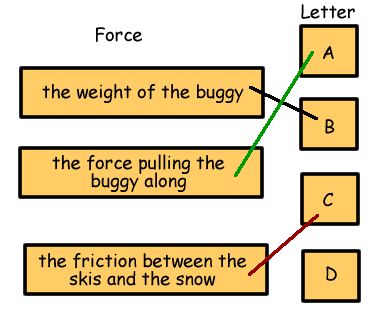Questions on Forces
Q7. The drawing shows a snow-buggy being pulled by a sail.
The buggy rests on three skis on the snow.

(a) The drawing above shows four forces that act when the snow-buggy is moving.
Draw a line from each force in the list below to the correct letter from the diagram. Draw only three lines.

3 marks
(b) A scientist travelled 80 kilometres each day in the buggy. How many kilometres did he travel in 10 days?
10 x 80 = 800 km
1 mark
(c) The buggy carried the scientist, food and equipment for the journey. The table shows how the total mass changed.
|
total mass at start of journey (kg) |
total mass at end of journey (kg) |
mass of buggy, scientist, food and equipment |
295 |
130 |
The buggy sank deeper into the snow at the start of the journey than at the end. Why did it sink deeper at the start? Use the table to help you.
any one from
- it weighed more
- the mass was greater accept 'it was heavier'
- it weighed less at the end
1 mark
(d) The buggy rests on three skis instead of three wheels. Why are skis better than wheels for travelling on snow?
Skis spread out the weight better than wheels do,  so that the force on a given area is smaller
so that the force on a given area is smaller  and they do not sink into the snow
and they do not sink into the snow
Skis have a bigger contact area with the snow than wheels do.  This reduces the pressure on the snow.
This reduces the pressure on the snow.  Therefore they do not sink into the snow as deeply as wheels would.
Therefore they do not sink into the snow as deeply as wheels would.
'they are bigger' or 'it can slide' is insufficient
2 marks MAX
(e) When a bigger sail is used, the buggy goes faster. How does a bigger sail help the buggy to go faster?
any one from
- there is a bigger surface or area to harness the wind's energy

- it catches more air or wind to power the sled.

Do not accept 'there is more air resistance'
The wind's energy is then transferred to the kinetic energy of the sled. A larger kinetic energy will result in a higher speed. 
2 marks
Maximum 9 marks


